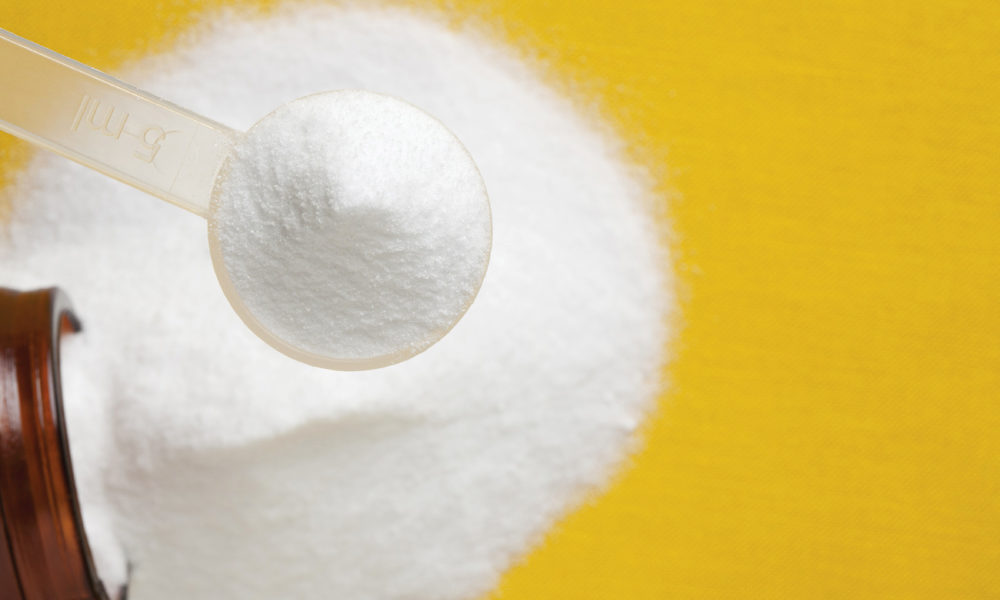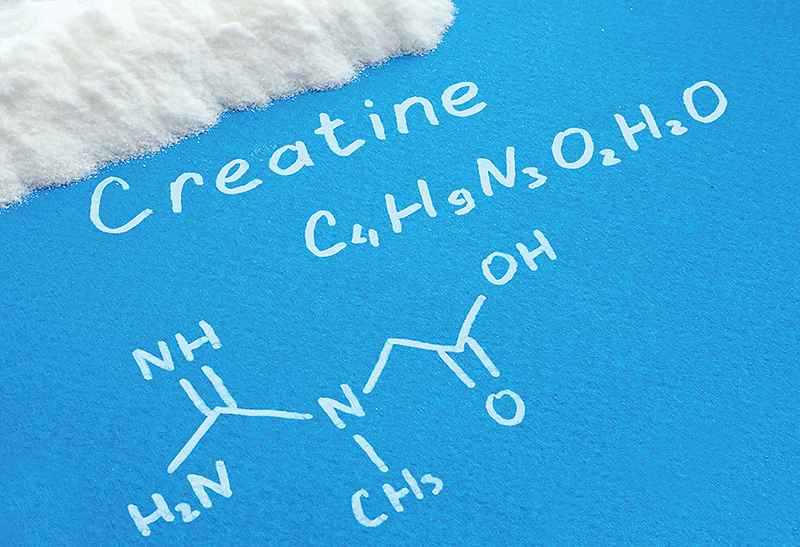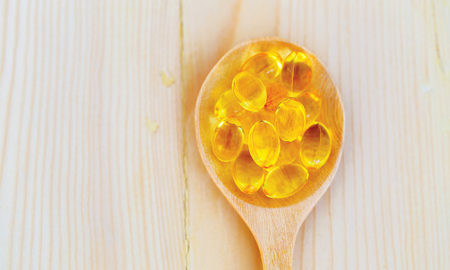

Everyone’s favorite muscle supplement has an interesting anabolic relationship with GH and IGF-1
By George L. Redmon, PhD, ND
PQ: “Researchers at the Laboratory of Exercise Physiology and Biomechanics at Chukyo University in Japan administered a single dose of 20 grams of creatine to healthy men at rest and saw an unexpected spike in growth hormone secretion over a six-hour period.”
PQ: “Creatine supplementation in combination with strength training amplifies the training induced increase in satellite cell number and myonuclei concentration in muscle fibers, which facilitates improved muscle fiber growth in response to strength training.”
“Creatine also helps muscle cells grow by increasing the amount of insulin-like growth factor-1 (IGF-1), a hormone crucial for muscle growth in muscle cells. New research has found that when subjects boost their muscle creatine levels via supplementation, they also increase genetic expression of IGF-1. So it appears that creatine may enhance muscle growth by influencing critical genes in cells that regulate this growth.”
—Jim Stoppani, PhD
Over the last two decades, creatine has become one of the most widely researched and utilized sports nutritional supplements of all time. Biologically formed from the amino acids glycine, arginine, and methionine, 95 percent of all creatine is found in skeletal muscle with the remaining five percent found within the heart, brain, and testes. What makes creatine so popular is its ability to assist in the regeneration of the high-energy molecule creatine phosphate. As we now know, creatine phosphate is the compound that serves as a rapid source of energy for muscle fibers to contract, which essentially improves the muscles workload capacity and recovery. Creatine also gained notoriety for its ability to up-regulate a process researchers refer to as cell volumizing. This process drives water and nutrients into the muscle causing it to swell. This irregularity substantially increases the muscle’s ability to house larger amounts of additional water and nutrients. From a physiological standpoint, this causes the muscle to signal the cells that it has grown and to accelerate protein synthesis (the creation of new proteins), building muscle mass in the body. Despite the accumulated data concerning creatinine’s anabolic and muscle-energizing abilities, researchers are still unraveling some of its unknown physiological attributes.

One understudied area of research is how creatine regulates the actions of genes in cells that stimulate growth, as well as its impact on insulin-like growth factor-1(IGF-1). Additionally, we will also review how creatine also impacts growth hormone (GH) and the inter-anabolic relationship that exist between these three dynamic compounds. Ironically, although IGF-1 regulates the actions of GH, IGF-1’s activation is initiated by GH via the liver. Despite this unique feedback mechanism between IGF-1and GH, new research indicates that creatine strengthens this connection and the action of these two dynamic anabolic heavyweights, an association that could be referred to as the creatine/IGF/GH axis of growth.
The Dynamics Of This Anabolic Axis Of Growth
GH is a household name in resistance-training circles and gets a lot of attention. Its anabolic effects are intertwined with and mediated by IGF-1. Growth hormone builds and repairs muscle tissue, as well as the remodels bone and collagen. GH also regulates your metabolism, which is essentially all the reactions that occur within your body, including fat-burning. In fact, GH stimulates fat cells (adipocytes) to release triglycerides into the blood stream for use as an energy source. GH also acts on peripheral or neighboring tissues that are independent of IGF-1 actions, even though it stimulates inborn IGF-1 production. GH also promotes the formation of what researchers call a ternary (things or parts arranged in groups of three) IGF-binding complex composed of subunits of proteins. This three-pronged grouping of proteins is referred to as IGF binding protein 3 (IGFBP-3), which stabilizes serum (the clear portion of fluid that remains after the solid elements have been separated out) IGF-1. While this last fact may seem like a moot point, it however serves in practical terms here as a dynamic anabolic symmetric ignition switch between GH and IGF-1.
IGF-1 And Preprogrammed Growth Instructions
IGF-1 is found within many different cell types and in many diverse kinds of tissue. It’s also present in the systemic circulation and is manufactured by peripheral or bordering tissues. Distinctively, IGF-1 binds to the IGF-1R receptor, which amplifies intracellular signaling. To put IGF-1 (also called somatomedin C) impact on growth into proper perspective, consider the fact that it is a protein comprised of 70 different amino acids that are preprogrammed by the IGF-1 gene. This biological factory sealed preprogrammed state could be comparable to your newly purchased laptop computer and the dynamic multifaceted capabilities of the processor inside it. However, in this case, the preprogrammed package of amino acids transforms IGF-1 into one of the most powerful natural activators of an anabolic pathway called the AKT signaling pathway. Incidentally, this anabolic pathway stimulates cell growth and proliferation, as well as preventing programmed apoptosis (cell death). However, more compelling here, in a recent study appearing in the scientific journal Molecular Cell, scientist discovered that in addition to IGF-1 regulating the IGF-1/PI3K/AKT pathway, that it simultaneously inhibits the upregulation of compounds that accelerate muscle atrophy. Researchers at Harvard University state that the catabolic muscle degeneration driven mainly by the above two compounds occur in a catabolic pathway called the ubiquitin-proteasome pathway.
Creatine Enhances This Anabolic Axis
Researchers at the Department of Physical Education and Rehabilitation at the Catholic University of Louvain in Belgium remind us that exercise directly stimulates the production of the insulin-like growth factors. In fact, in a recent trial, these researchers found that three hours following a workout, IGF-1 was elevated by 24 percent, and at 24 hours (post-workout) IGF-I peaked at over 29 percent. As you know, GH is also released into the bloodstream following workouts and during sleep. However, what these researchers didn’t expect was an increase in IGF-1 mRNA signaling in non-training subjects or resting muscle by 30 percent following five grams of creatine for 21 days. Equally, researchers at the Laboratory of Exercise Physiology and Biomechanics at Chukyo University in Japan administered a single dose of 20 grams of creatine to healthy men at rest and saw an unexpected spike in growth hormone secretion over a six-hour period, which registered a high of 83 percent as compared to 45 percent in controls. These researchers concluded that in resting conditions and at high dosages, creatine enhances GH secretion, mimicking the response of strong exercise via heightened signaling of the IGF-1 mRNA. As a further point of reference, genes hold the information to build and maintain your cells. Biochemically, transcription is the first step of gene expression, meaning instructing the cells how to carry out the instructions embedded in those genes.
In practical terms, creatine activates the release of the anabolic and metabolic commands encoded within the IGF-1/GH axis, even without an exercise-induced trigger. In fact, from all indications, creatine supplementation directly stimulates the production of the insulin-like growth factors IGF-1 and IGF-2 (IGF-2 is a dynamic but less potent growth factor than IGF-1).

Creatine And Satellite Cells
Researchers at the Université Paris Val de Marne in France state that adult skeletal muscle is capable of regenerating after injury due to the activation of dormant muscle precursor cells known as satellite cells. These cells proliferate and separate to form new myotubes, which eventually develop into mature muscle fibers. Likewise, there is extensive verified research that confirms that creatine enhances the development of new skeletal muscle and increases the muscles work-load capacity via its impact on satellite cell production. For example, in a recent double blind study appearing in The Journal of Physiology, researchers examined the influence of creatine and protein supplementation on satellite cell frequency and the number of myonuclei in human skeletal muscle during 16 weeks of heavy resistance training. In this study, 32 healthy male subjects (19 to 26 years) were assigned to strength-training protocols while receiving a scheduled intake of creatine (six to 24 grams creatine monohydrate), protein (20 grams), a placebo, and a non-training control group. All training regimens were found to increase the proportion of satellite cells, but significantly greater enhancements were observed with creatine supplementation at week four as compared to placebo, and at eight weeks compared to the protein group and placebo. Furthermore, creatine supplementation resulted in an increased number of myonuclei per fiber and increases of 14 to 17 percent in muscle fiber area at weeks four, eight, and 16. Conversely, the protein group showed an increase in muscle fiber area, however, only after 16 weeks and the training control group only by week four of training.
What was most fascinating here was that these researchers discovered that the old and newly acquired nuclei were retained even during severe atrophy over the course of several years. As a note here, based on research conducted at the Department of Molecular Biosciences at the University of Oslo in Norway, myonuclei are protected from the high apoptotic (preprogrammed death) activity found in inactive muscle tissue.
The take-home message here is that the effects of previous strength-training adaptations remain in the muscle’s memory bank, namely the myonuclei, even after prolonged inactivity accounting for this distinctive anabolic irregularity. Based on the above findings, this moves creatine way beyond the aspects of just being a compound that supply’s energy to facilitate muscle contractions.
New Perspective On Creatine
These researchers concluded that this study demonstrated that creatine supplementation in combination with strength-training amplifies the training-induced increase in satellite cell number and myonuclei concentration in muscle fibers, which facilitates improved muscle fiber growth in response to strength training. Researchers at the Randall Division of Cell and Molecular Biophysics at King’s College London remind us that muscle growth can be achieved “by either an increase in muscle fibre number or an increase in the size of individual myofibres or a combination of both.” However, myofiber hypertrophy during growth requires the addition of new myonuclei, which are supplied by muscle satellite cells, the resident stem cells of skeletal muscle.
Despite the scientific jargon above, it is important to remember that muscle regeneration and hypertrophy are facilitated by the activation and the multiplication of muscle satellite cells and myonuclei are generated by insulin-like growth factor 1 (IGF-1). Uniquely, these inborn building and repair responses to damage and or inactivity of the muscle appear to be fueled and regulated by creatine’s ability to facilitate the release of transcription messages encoded within certain IGF-1genes and enhanced growth hormone production.
In retrospect, when you consider creatine’s present rise versus the overall short time frame it took to reach its present status, this truly represents how effective it is at influencing many anabolic pathways and metabolic processes that drive the anabolic continuum. The emerging proposed anabolic and systemic physiological attributes associated with creatine may not make it the most utilized supplement in the sports medicine arena, but across a variety of medical categories and specialties as well. IM


















You must be logged in to post a comment Login